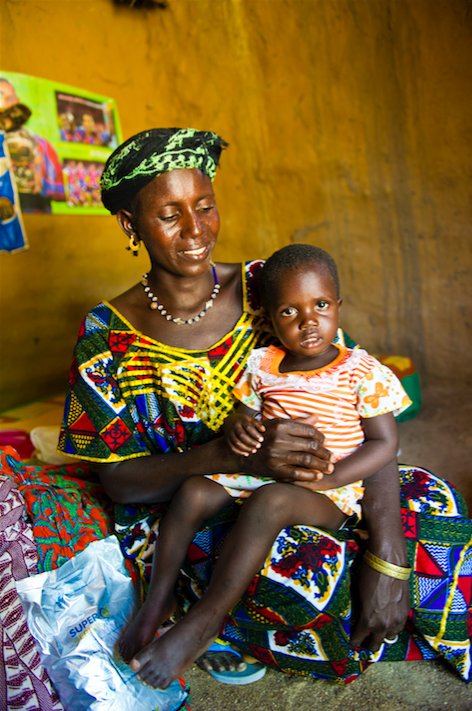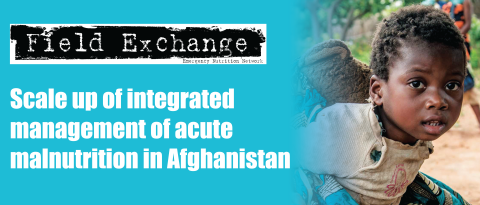Effectiveness of food supplements in increasing fat-free tissue accretion in children with moderate acute malnutrition in Burkina Faso
Summary of research1
Location: Burkina Faso
What we know: There is no consensus on the effectiveness of lipid-nutrient supplement (LNS) compared to corn-soy blend (CSB) in the treatment of moderate acute malnutrition (MAM), or on the role of key factors like milk and soy.
What this article adds: A randomised trial of 1,609 children aged 6-23 months with MAM conducted in Burkina Faso investigated the effectiveness of (a) matrix (i.e. LNS or CSB); (b) soy quality (i.e. soy isolate (SI) or dehulled soy (DS)); and (c) percentage of total protein from dry skimmed milk, in increasing fat-free tissue accretion. Compared to children who received CSB, fat-free mass index (FFMI) accretion increased in those who received LNS. SI did not increase FFMI compared to DS, irrespective of matrix. Having 20 per cent milk protein was associated with greater FFMI accretion than having no milk protein; this difference was not significant (p = 0.055), and there was no effect of 50 per cent milk. LNS compared to CSB resulted in 128g (95% CI 67, 190; p<0.01) greater weight gain if both contained SI, but there was no difference between LNS and CSB if both contained DS. The study found that children mainly gained fat-free tissue when rehabilitated. LNS yields more fat-free tissue and higher recovery rates than CSB. LNSs with DS may be improved by shifting to SI.
Background
Moderate acute malnutrition (MAM) is widespread among children in low-income countries, affecting 33 million children at any time (Black et al, 2013) and is a risk factor for morbidity, severe acute malnutrition (SAM) and death. There is limited evidence to inform recommendations on the composition of supplementary foods to treat children with MAM. Supplementary foods for malnourished children are based on a matrix of either corn-soy blend (CSB) or lipid-based nutrient supplement (LNS). There are substantial differences between the two product types in nutritional composition, cost, how they are consumed and logistics needed for delivery. A key source of protein in CSB is soy; this is often dehulled soy (DS), which contains higher levels of anti-nutrients (compounds impairing absorption of minerals) compared to more expensive soy isolate (SI). The first LNS product (ready-to-use therapeutic food) was developed to treat SAM and was based on the nutritional composition of the therapeutic milk F-100, containing high amounts of dairy products and no soy. More recently, a range of LNS products, some containing soy, has been developed for treatment of MAM. The inclusion of dry skimmed milk (DSM) in supplements improves the amino acid profile, provides minerals with high bioavailability and reduces the content of anti-nutrients when it replaces vegetable protein sources, but also increases costs. There is concern that children receiving LNS might accumulate too much fat tissue.
Trials assessing the effects of supplements typically use weight gain or nutritional recovery (i.e. weight-for-height z-score (WHZ) or mid-upper arm circumference (MUAC) above specific cut-offs) as the primary outcome and do not consider body composition; however, inadequate accretion of fat-free tissue (i.e. muscle, organ tissue and bone) impairs body function and health. The aim of this study was to investigate the effectiveness of matrix, soy quality and percentage of total protein from DSM in the treatment of MAM in increasing fat-free mass (FFM) accretion.

Methods
Between 9 September 2013 and 29 August 2014, a randomised 2×2×3 factorial trial recruited children aged 6 to 23 months with MAM in Burkina Faso. The intervention comprised 12 weeks of food supplementation providing 500 kcal/day as LNS or CSB, each containing SI or DS; and 0, 20 or 50 per cent of protein from milk. FFM was assessed by deuterium dilution technique. By dividing FFM by length squared, the primary outcome was expressed independent of length as FFM index (FFMI) accretion over 12 weeks. Other outcomes comprised recovery rate and additional anthropometric measures.
Findings
Of 1,609 children, four died, 61 were lost to follow-up and 119 were transferred out due to supplementation being switched to non-experimental products. No children developed allergic reaction. At inclusion, 95 per cent were breastfed, mean (SD) weight was 6.91 kg (0.93), with 83.5 per cent (5.5) FFM. In the whole cohort, weight increased 0.90 kg (95% CI 0.88, 0.93; p<0.01) comprising 93.5% (95% CI 89.5, 97.3) FFM. Compared to children who received CSB, FFMI accretion increased by 0.083 kg/m2 95% CI 0.003, 0.163; p = 0.042) in those who received LNS. SI did not increase FFMI compared to DS (mean difference 0.038 kg/m2; 95% CI −0.041, 0.118; p = 0.35), irrespective of matrix. Having 20 per cent milk protein was associated with 0.097 kg/m2 (95% CI−0.002, 0.196) greater FFMI accretion than having 0 per cent milk protein, although this difference was not significant (p = 0.055) and there was no effect of 50 per cent milk protein (0.049 kg/m2; 95% CI−0.047, 0.146; p = 0.32). There was no effect modification by season, admission criteria, baseline FFMI, stunting, inflammation or breastfeeding (p >0.05). Over the 12-week supplementation period, LNS compared to CSB resulted in 128g (95% CI 67, 190; p<0.01) greater weight gain if both contained SI, but there was no difference between LNS and CSB if both contained DS (mean difference 22 g; 95% CI−40, 84; p = 0.49) (interaction p = 0.017). Accordingly, SI compared to DS increased weight by 89 g (95% CI 27, 150; p = 0.005) when combined with LNS, but not when combined with CSB.
Overall, the recovery rate was seven per cent higher for LNS versus CSB (69 per cent versus 62 per cent; p= 0.002), and the non-response rate was six per cent per cent lower (24 per cent versus 30 per cent; p= 0.007); there was no difference in development of SAM (7.3 per cent versus 8.7 per cent; p= 0.31). There were no significant differences between DS and SI with respect to recovery rate, non-response rate and risk of SAM. Likewise, there were no significant differences between 0, 20 and 50 per cent milk protein in recovery rate, non-response rate and risk of SAM.
A limitation of this and other food supplementation trials is that it is not possible to collect reliable data on individual adherence.
Conclusions
Based on this study, children with MAM mainly gain fat-free tissue when rehabilitated. Children given LNS did not put on excessive fat and LNS yielded more fat-free tissue and higher recovery rates than CSB. Results also show that current LNSs with DS may be improved by shifting to SI. The role of milk relative to soy merits further research. These findings support a wider use of LNS in the treatment of children with MAM. The authors conclude that a switch to LNS would lead to greater gain of fat-free tissue and recovery and would benefit millions of children.
Endnotes
1Fabiansen C, Yame ´ogo CW, Iuel-Brockdorf A-S, Cichon B, Rytter MJH, Kurpad A et al. (2017) Effectiveness of food supplements in increasing fat-free tissue accretion in children with moderate acute malnutrition: A randomised 2×2× 3 factorial trial in Burkina Faso. PLoS Med 14(9): e1002387.https://doi.org/10.1371/journal. pmed.1002387
References
Black RE, Victora CG, Walker SP, Bhutta ZA, Christian P, de Onis M et al. Maternal and child undernutrition and overweight in low-income and middle-income countries. Lancet. 2013; 382:427–51. https:// doi.org/10.1016/S0140-6736(13)60937-X PMID: 23746772


